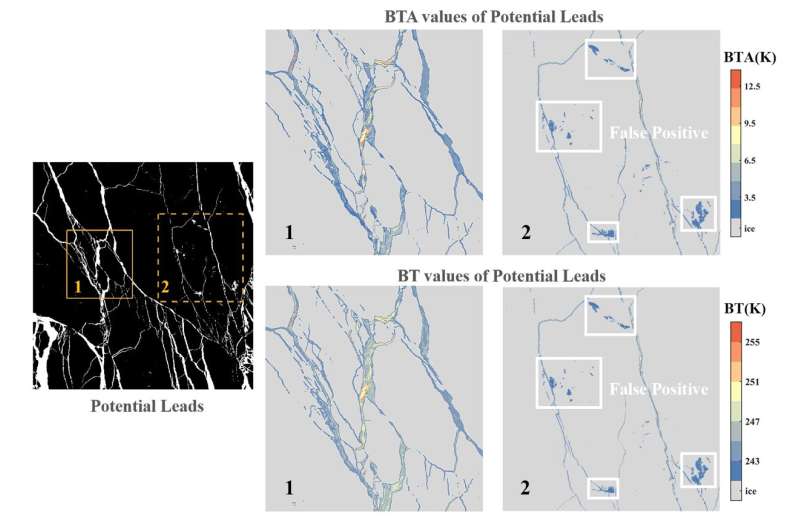This article has been reviewed according to Science X's editorial process and policies. Editors have highlighted the following attributes while ensuring the content's credibility:
fact-checked
peer-reviewed publication
trusted source
proofread
More Arctic sea ice cracks spotted by SDGSAT-1 satellite

Based on spaceborne high-resolution thermal infrared observation, a research team from the International Research Center of Big Data for Sustainable Development Goals (CBAS) and the Aerospace Information Research Institute (AIR) of the Chinese Academy of Sciences (CAS) has detected more sea ice leads in the Arctic Ocean than previously observed. The study was published in The Cryosphere on July 14.
Leads—cracks or fissures that initiate inside an otherwise continuous sea ice—play important roles in heat exchange between the ocean and the overlying atmosphere. Specifically, narrow leads with widths less than a hundred meters make an important contribution to the Arctic sea ice retreat.
However, spaceborne thermal infrared remote sensing has long been limited to moderate resolutions ranging from hundreds of meters to kilometers, thus posing a challenge in understanding the Arctic sea ice dynamics.
The team applied the Thermal Infrared Spectrometer (TIS) onboard the Sustainable Development Science Satellite 1 (SDGSAT-1) to detect sea ice lead at an unprecedented 30-m resolution. For the first time, the spatial resolution of leads by infrared remote sensing increased from the scale of kilometers to tens of meters.
Compared with the Moderate-Resolution Imaging Spectroradiometer (MODIS), the TIS presented more leads with widths less than hundreds of meters.
The case study showed that the lead area detected by SDGSAT-1 was 1.3 times larger than that observed by MODIS, suggesting that more leads exist in the Arctic Ocean ice than previously observed.
This research highlights the potential of the SDGSAT-1 satellite for high-resolution sea ice observation in the polar regions and provides insights into the contribution of narrow leads to rapid sea ice changes in the Arctic.
More information: Yujia Qiu et al, Spaceborne thermal infrared observations of Arctic sea ice leads at 30 m resolution, The Cryosphere (2023). DOI: 10.5194/tc-17-2829-2023
Journal information: The Cryosphere
Provided by Chinese Academy of Sciences





















